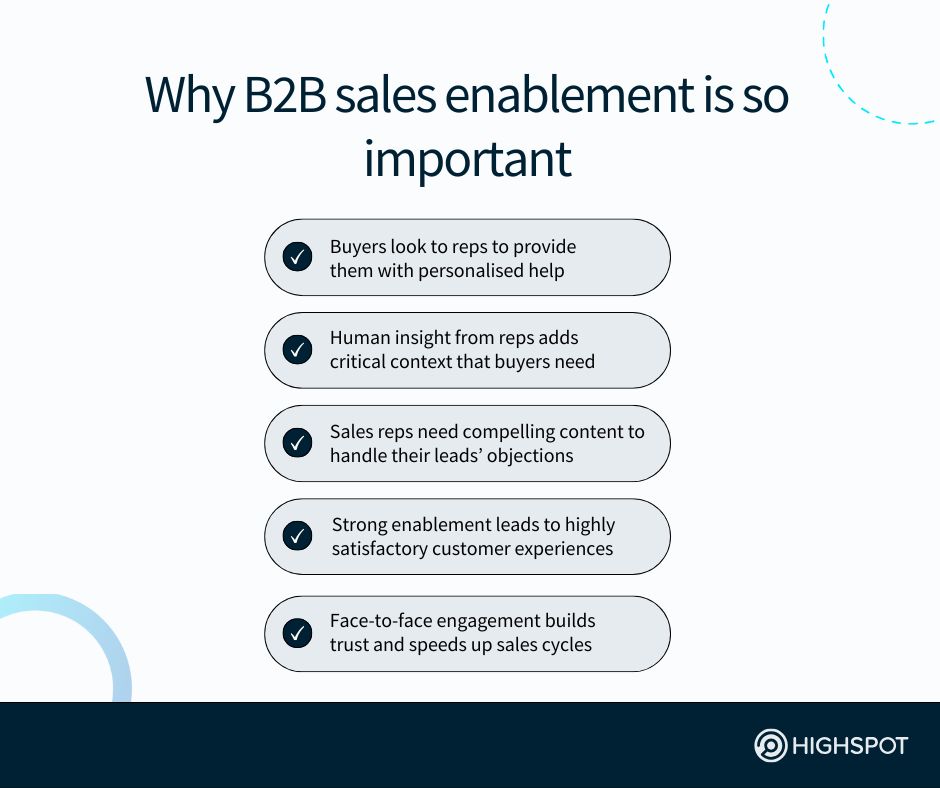Key takeaways
- Constant communication and collaboration among sales, marketing, and enablement is the foundation of any successful B2B sales enablement strategy today.
- Ongoing sales rep training and coaching and analysis and adjustment of content provided to and plays executed by sellers lead to B2B sales improvements.
- Buy-in and continual support from go-to-market (GTM) leadership is crucial to building highly impactful—and high-converting—sales enablement approaches.
Gartner’s 2025 sales engagement survey revealed 61% of B2B buyers now prefer a sales-representative-free buying experience—but don’t let this statistic fool you into thinking sales reps are becoming obsolete.
Many buyers may value the autonomy and convenience of digital customer journeys.
The reality, though, is that potential customers still require human interaction (and a lot of it) to make well-informed and timely decisions about B2B products and services.
This is especially the case in complex, high-stakes purchasing processes in which their businesses are spending tens or hundreds of thousands of dollars. (Think deals tied to software subscriptions that require annual or multi-year contracts.)
We get it: Digital-first buying experiences offer speed, ease, and convenience for B2B buyers. That said, your sales team continues to hold significant value to them.
That’s because your sales reps can apply the much-needed human touch to deal discussions that buyers—whether they admit it or not—seek when making complex, costly decisions.
Revenue enablement, sales operations, and related business leaders at your company know they still need highly skilled sales team members to proactively interact with prospects passed to them via lead-generation activities from marketing.
What’s more, these VPs and directors know their sellers must use influential and captivating sales materials that marketing creates to address buyers’ wants, needs, and challenges.
The problem these go-to-market (GTM) leaders face today is building B2B sales enablement programmes that best support their teams—from brand-new business development reps to established account executives—in their efforts to close high-value deals at scale.
Watch our video to learn what modern B2B sales enablement entails.
What is B2B sales enablement?
Modern B2B sales enablement is a strategic, collaborative discipline designed to equip customer-facing teams with the resources, skills, and insights needed to engage buyers effectively and drive predictable revenue growth.
The approach aligns sales, marketing, and enablement around shared goals, ensuring teams deliver consistent, compelling buyer experiences throughout every stage of the sales cycle.
Ultimately, B2B sales enablement empowers sales reps to execute strategic initiatives, measure their impact, and continuously improve performance based on sales data and insights.
However, every GTM team plays a part in the success of B2B buyer enablement strategies.
Sales and marketing teams working together
“In any thriving organisation, whether an enterprise or a small business, sales and marketing serve as the backbone, driving growth through deal-closing and brand-building activities,” Highspot’s “Best Practices for Sales and Marketing Strategies” guide explains—and it’s true.
Only when marketing and sales enablement stakeholders sync early and often regarding what collateral will most help reps conduct cold outreach to prospects, engage leads already in their sales pipeline, and close more deals can they execute enablement efforts that drive tangible results.
Enablement focusing on content management
Through marketing and sales team collaboration, B2B sales enablement teams can turn their attention to:
- Content marketing: Developing detailed assets that can be leveraged for account-based selling, ad-hoc prospect and customer engagement, and content management.
- Content management: Using analytics tools—ideally, in a purpose-built B2B sales enablement platform like Highspot, which offers a native AI and analytics engine—to assess which collateral is used most and least by sales reps, which assets need to be refreshed, and which content helps close more deals and influence pipeline and revenue.
Product marketing teams often have a say (as they should) in the creation of product-centric content that can be utilised by reps across the entire enterprise sales cycle.
However, it’s enablement teams that ultimately leverage their marketing colleagues’ messaging and positioning materials and guidance to provide hands-on sales enablement training to reps, like how to create bespoke digital sales rooms for accounts.
Managers providing sales coaching and training
Sales managers work one-on-one with individual reps and conduct monthly or bimonthly training sessions to ensure their teams know how to make the most of sales enablement content as well.
Every B2B sales strategy today only excels when sales managers pay close attention to how their reps leverage data from their customer relationship management (CRM) software and sales enablement technology in tandem to deliver a strong customer experience to every buyer in their pipeline.
While using analytics tools to evaluate the performance of potentially dozens of sales reps isn’t feasible for enterprise managers, many now use leading sales enablement systems with native AI and sales analytics functionality that offer AI sales coaching capabilities and actionable insights that can automate some rep training.
What makes B2B sales enablement important
A B2B sales enablement playbook, developed through sales and marketing alignment and with the support of revenue and sales operations leaders, helps reps (and even customer success teams) get regular B2B sales training to increasingly improve their buyer engagement efforts.

Empowering highly effective customer engagement
When onboarded effectively, given ongoing training, and provided with richly detailed and compelling sales enablement materials, sales reps accumulate industry insight and gain the necessary sales skills to help buyers see beyond mere features and understand the genuine, long-term business impact of their companies’ offerings.
Even as digital-first buying grows, your sales team remains crucial because:
- Buyers seek personalised guidance to navigate intricate purchases and sales cycles
- Human insight helps buyers see beyond superficial features to real business value
- Sales reps can effectively respond to objections and nuanced questions in real-time
- Strong relationships built by reps can help establish long-term customer loyalty
- Face-to-face prospect engagement accelerates trust and shortens sales cycle length
In short, a cohesive B2B sales enablement approach ensures sales, marketing, and enablement teams remain on the same page, delivering a unified and persuasive buyer experience. Such alignment enhances buyer interactions and improves internal team efficiency and collaboration.
Using advanced enablement and automation tools
The only way to realise such a cohesive, well-executed sales enablement plan, though, is with unified B2B sales enablement software that streamlines the sales activities (among many others) and empowers reps to boost their sales performance the most.
As Turnitin Director of Sales Enablement Anthony Doyle shared in Highspot’s State of Sales Enablement Report 2025, having our platform at the centre of the company’s GTM tech stack allows his team to centralise content marketing materials for reps. This, in turn, helps them:
- Craft custom-tailored sales pitches to prospective and existing customers
- Lead smarter sales conversations based on buyers’ requests for information
- Facilitates better (and faster) sales outcomes (closed deals, upsells, cross-sells)
“It’s incredibly important to have a unified sales enablement platform to centralise knowledge and buyer engagement,” said Doyle. “One platform affords a lot of rich data and AI, so sellers can get resources and insights very quickly to engage their customers. That’s the value you get from a unified platform versus disparate systems that don’t communicate.”
The modern sales enablement framework
No two B2B sales processes or enablement strategies will look alike. That said, the best approaches follow the same relative framework.
Here are five ways GTM leaders can help their reps thrive day in and day out.
Awareness: Conducting outreach to prospects
Effective B2B sales enablement is all about giving your sales reps exactly what they need to engage prospects confidently from the start: targeted messaging, relevant insights, and compelling content to spark curiosity and initiate meaningful conversations.
Investigation: Hosting discovery calls with leads
Reps can only host productive sales discovery calls when they have detailed buyer personas, industry context, and strategic questioning techniques. These enablement resources help reps quickly uncover prospects’ true pain points, goals, and motivations.
Well-prepared sales discovery calls driven by enablement insights from your CRM software and other GTM tools ensure that conversations stay focused and aligned with the prospect’s specific needs.
Commitment: Detailing the value of your product
In this critical phase, enablement assets help reps clearly articulate the unique value of their companies’ products and services and address leads’ questions and concerns.
Enablement delivers tailored messaging frameworks, impactful customer stories, and data-driven proof points to strengthen their sales pitches and presentations.
By connecting the dots between prospect challenges and your organisation’s offerings, enablement ensures reps confidently communicate your product’s differentiated value.
Selection: Making the case against competitors
Effective enablement equips sales reps with targeted, precise messaging to address competitive threats directly. Detailed competitive battle cards, real-world examples, and clear positioning statements empower reps to confidently and convincingly differentiate your offering.
By clearly expressing the competitive advantages of your products and services, enablement supports your reps in steering conversations towards why your solution is the superior choice.
Validation: Closing deals with key stakeholders
This is where personalised, persuasive arguments that speak directly to key stakeholder priorities come into play. Reps share robust ROI calculations, detailed case studies, and custom-tailored digital sales rooms to reinforce buyer confidence in their purchasing decision.
With rich insight into an entire account’s history and relevant enablement resources, your reps can capably address lingering concerns decisively, paving the way for successful deal closures.
Evolving your B2B sales enablement strategy
“Most B2B sales organisations have an unsustainably large amount of transformation debt, a backlog of improvements that should have been made long ago but weren’t,” Forrester Principal Analyst Rick Bradberry recently wrote. “These improvements are often shelved in favour of short-term sales goals.”
The result of this shortsightedness? Mid-market and enterprise sales teams alike are put “further back on the change curve,” Bradberry noted. This leaves them vulnerable to competitors with more sophisticated sales strategies that rely on advanced AI sales enablement tools and workflows.
To stay ahead of your competition—and make progress with your B2B growth strategy (read: increasing your average contract size and annual recurring revenue)—you need:
- A supportive leadership team willing to fully invest in an enablement strategy
- In-house sales enablement experts to ‘steer the ship’ and aid each sales rep
- Best-in-class B2B sales enablement software that everyone in GTM can leverage
Only when these three boxes are checked can your business have the people, processes, and tech stack in place that can put some of your most essential sales activities on autopilot and empower your sellers to connect with would-be customers and clients with confidence.




